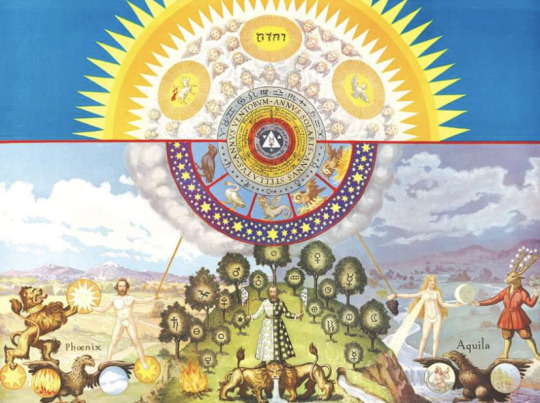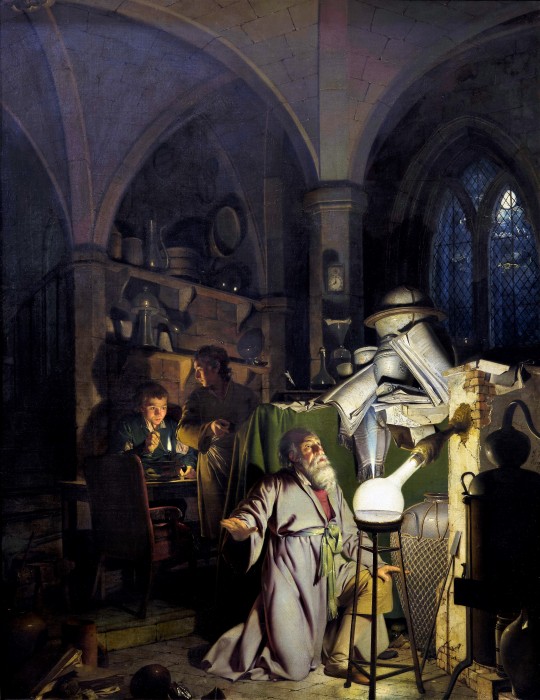#Rosicrucianism
Quote
In Advancement of Learning, [Francis] Bacon argues that just as there are 'brotherhoods' in families and those associated with certain skills (crafts guilds), there should also be a 'fraternity in learning and illumination.' By 1586, the Fra Rosi Crosse Society, or the Order of the Rosicrucians, which became a degree in the Knights of the Helmet. Bacon later gave the group the name of Acception Masons, who were to carry out the long-term objectives of societal reform outlined in the Advancement of Learning...
...At Gray's Inn, Bacon was a member of the Order of the Helmet, dedicated to the goddess Pallas Athena, who was most often represented dressed in armor like a male soldier, holding a spear in her right hand, with a serpent writhing at her feet, and wearing a Corinthian helmet raised high atop her forehead. Developed in the early seventeenth century BC, the 'Corinthian style' helmet had no earl holes, but had solid nose guard a phallic cap-shaped crown. It is also known as the Cap of Hades, Helm of Hades, or Helm of Darkness. Wearers of the cap in Greek myths include Athena, the goddess of wisdom, the messenger god of Hermes, and the hero Perseus. Rabelias called it the Helmet of Pluto, and Erasmus the Helmet of Orcus, a Roman god of the underworld.
In classical mythology, the helmet was also known as the Cap of Invisibility that can turn the wearer invisible. According to Bacon, 'the helmet of Pluto, which maketh the politic man go invisible, is secrecy in the counsel, and celerity in the execution.' Thus the members of the Order of the Helmet likewise served 'invisible' to the world, much of their labour being published anonymously or under pseudonyms. To signify their vow of invisibility the knights of the order all had to kiss Athena's helmet. Pallas Athena was known as 'the Spear Shaker', or the 'Shaker of the Spear', while the cryptically hyphenated version of the name 'Shake-Speares' appeared on the title pages of certain plays of Shakespeare, and on every page of the first edition of his sonnets.
David Livingstone (Ordo Ab Chao: The Grand Lodge, Chapter 1: The Elizabethen Age: Knights of the Helmet, pg. 5-6, 2022)

#rosicrucian#rosicrucianism#knights of the helmet#pallas athena#francis bacon#elizabethen age#western esotericism#western esoteric tradition#occultism#history#occult history#ordo ab chao#david livingstone#fra rosi crosse society#order of the rosicrucians#william shakespeare#shakespeare#literature#english history#england#pluto#sir francis bacon
29 notes
·
View notes
Text
‘En de Rozenkruisers?’
‘Doodse stilte. Post 120 annos patebo geen ene moer. Zij kijken toe vanuit hun niet-bestaande paleis. Ik geloof dat het juist die stilte was waardoor de gemoederen zo verhit raakten. Als ze niet antwoorden betekent dat dat ze echt bestaan.’
(…)
‘Sommigen zeggen dat ze niet bestaan omdat zij niet benaderd zijn, anderen zeggen dat ze juist bestaan om benaderd te worden.’
- Umberto Eco, De Slinger van Foucault
#eco#umberto#umberto eco#foucault#slinger#slinger van foucault#foucault’s pendulum#pendulum#dutch#nederlands#rozenkruiser#rozenkruisers#rosy cross#Rosicrucianism#rosicrucian
4 notes
·
View notes
Quote
The wise man seeks what he loves and loves only that which he knows: otherwise he would be a fool. Out of knowledge therefore cometh love, the Truth of all, which alone is esteemed by all just philosophers.
Sapiens, Brother R.C., quoted in Anima Magia Abscondita by Eugenius Philalethes
16 notes
·
View notes
Text

#rosicrucian#witchcraft#occult#rosicrucianism#symbols of the trinity#magic#alchemist#knowledge#phoenix#aquila
10 notes
·
View notes
Text

Rosicrucian Initiation - Dr Robert Gilbert
Dr. Robert Gilbert: Rosicrucianism, Spiritual Warfare, and Our Global Ascension
Bio Geometry, Alchemy, Rosicrucianism, Stem Cell, Golden Age
Explanation of the symbol: The Rosicrucian cross designed by Stanislas de Guaita in 1888, and reproduced by Oswald Wirth in Le Tarot des Imagiers du Moyen Age, 1927. The four letters of the Tetragrammaton, making up the Hebrew name of God, mark the arms of the cross. The five letters in the triangles of the pentagram make up the name Jehousha, or Jesus, the 'Man-God'. The central aleph, or Hebrew letter A, is symbolic of Adam, the first Man, who fell, and who was redeemed by Christ. The word Rosicrucian is believed to be a combination of the Latin Ros (which means both Rose and Dew) and the Latin Crucis, the generative of the Latin name for Cross. The symbol is that of the Rosy-Cross, and it was a symbolic masterstroke of de Guaita to arrange four roses in such a way as to form an ancillary cross. There are 10 Hebrew letters in the design, and 10 is marked in the Roman system by the Cross [X].
0 notes
Text
Alchemy Unveiled: A Mystical Odyssey Through the Ages

Arthur Edward Waite's "Lives of Alchemystical Philosophers" is a captivating journey through the annals of history, offering readers a profound exploration of the lives and philosophies of those enigmatic figures who sought the mystical secrets of alchemy.
In this meticulously researched work, Waite, a distinguished scholar of occultism, weaves a tapestry of narratives that brings to life the alchemists who, throughout the ages, delved into the transformative realms of spiritual and material transmutation. The book goes beyond a mere historical account, presenting these alchemists as multidimensional characters driven by an insatiable quest for knowledge and the philosopher's stone.
Waite's narrative prowess shines as he navigates the intricacies of alchemical symbolism and the hermetic traditions, providing readers with a comprehensive understanding of the cultural, philosophical, and spiritual contexts that shaped the lives of these alchemical pioneers. The author's erudition is evident as he seamlessly blends historical facts with esoteric insights, creating a narrative that is both informative and enchanting.
One of the book's strengths lies in its ability to demystify the often cryptic world of alchemy, making it accessible to readers with varying levels of familiarity with the subject. Waite adeptly bridges the gap between scholarly research and readability, ensuring that "Lives of Alchemystical Philosophers" serves as an engaging introduction for novices while offering depth for seasoned enthusiasts.
The author's portraits of alchemists such as Paracelsus, Flamel, and Hermes Trismegistus are vivid and compelling. Each chapter unfolds like a captivating story, revealing the struggles, triumphs, and profound insights of these alchemical visionaries. Waite's narrative style invites readers to embark on a mystical journey alongside these historical figures, encouraging a personal connection with their quests and discoveries.
In conclusion, "Lives of Alchemystical Philosophers" is a masterfully crafted exploration of a subject often shrouded in mystery. Arthur Edward Waite's expertise and passion for the occult shine through, making this book an invaluable resource for anyone intrigued by the intersection of history, mysticism, and the perennial quest for enlightenment.
Arthur Edward Waite's "Lives of Alchemystical Philosophers" is available in Amazon in paperback 17.99$ and hardcover 25.99$ editions.
Number of pages: 429
Language: English
Rating: 8/10
Link of the book!
Review By: King's Cat
#Alchemists#Philosopher's Stone#Hermetic Traditions#Occultism#Mysticism#Transmutation#Paracelsus#Flamel#Hermes Trismegistus#Esotericism#Symbolism#Spiritual Alchemy#Historical Alchemy#Alchemical Philosophy#Transformation#Manuscripts#Medieval Mystics#Secret Knowledge#Rosicrucianism#Spiritual Enlightenment
0 notes
Text
Alchemy Unveiled: A Mystical Odyssey Through the Ages
Arthur Edward Waite's "Lives of Alchemystical Philosophers" is a captivating journey through the annals of history, offering readers a profound exploration of the lives and philosophies of those enigmatic figures who sought the mystical secrets of alchemy.
In this meticulously researched work, Waite, a distinguished scholar of occultism, weaves a tapestry of narratives that brings to life the alchemists who, throughout the ages, delved into the transformative realms of spiritual and material transmutation. The book goes beyond a mere historical account, presenting these alchemists as multidimensional characters driven by an insatiable quest for knowledge and the philosopher's stone.
Waite's narrative prowess shines as he navigates the intricacies of alchemical symbolism and the hermetic traditions, providing readers with a comprehensive understanding of the cultural, philosophical, and spiritual contexts that shaped the lives of these alchemical pioneers. The author's erudition is evident as he seamlessly blends historical facts with esoteric insights, creating a narrative that is both informative and enchanting.
One of the book's strengths lies in its ability to demystify the often cryptic world of alchemy, making it accessible to readers with varying levels of familiarity with the subject. Waite adeptly bridges the gap between scholarly research and readability, ensuring that "Lives of Alchemystical Philosophers" serves as an engaging introduction for novices while offering depth for seasoned enthusiasts.
The author's portraits of alchemists such as Paracelsus, Flamel, and Hermes Trismegistus are vivid and compelling. Each chapter unfolds like a captivating story, revealing the struggles, triumphs, and profound insights of these alchemical visionaries. Waite's narrative style invites readers to embark on a mystical journey alongside these historical figures, encouraging a personal connection with their quests and discoveries.
In conclusion, "Lives of Alchemystical Philosophers" is a masterfully crafted exploration of a subject often shrouded in mystery. Arthur Edward Waite's expertise and passion for the occult shine through, making this book an invaluable resource for anyone intrigued by the intersection of history, mysticism, and the perennial quest for enlightenment.

Arthur Edward Waite's "Lives of Alchemystical Philosophers" is available in Amazon in paperback 17.99$ and hardcover 25.99$ editions.
Number of pages: 429
Language: English
Rating: 8/10
Link of the book! (Hardcover); (Paperback)
Review By: King's Cat
#Alchemists#Philosopher's Stone#Hermetic Traditions#Occultism#Mysticism#Transmutation#Paracelsus#Flamel#Hermes Trismegistus#Esotericism#Symbolism#Spiritual Alchemy#Historical Alchemy#Alchemical Philosophy#Transformation#Manuscripts#Medieval Mystics#Secret Knowledge#Rosicrucianism#Spiritual Enlightenment
0 notes
Text
Certain secret societies, such as the Freemasons, practice prisca theologia: the belief in a single, true theology which all modern religions and belief systems were based on. The idea being this theology was passed down the the first humans by God and spread to disparate religions and philosophies. In other words, prisca theologia is the idea that all theologies today derive from this original theology.
These societies purport to be the sole successors of this original theology, a secret hidden knowledge only they are allowed to know. A significant role in esotericism and the occult is the performance of magical rites to divine this hidden knowledge. Some orders that follow this principle are the Freemasons, Hermetic Order of the Golden Dawn and the Rosicrucians.
The notion that a certain group holds the key to secret knowledge, while lacking any credible evidence of said knowledge, is arguably delusional and certainly elitist.
#freemasons#esoterism#mysticism#occult#theology#magic#magical rites#religion#philosophy#alchemy#hermeticsim#rosicrucian#rosicrucianism#freemasonry#freemasonic
0 notes
Text
youtube
Have you ever wondered how Charles Darwin’s Theory of Evolution came to be? Delve into the mystical origins of natural selection and reveal the ‘missing link’ between its creators and their devout occult religious beliefs. Discover how the roots of evolutionary biology extend deep into the ancient Mystery religions. Not only that, but this belief is so ancient it has widespread implications regarding some monumental historical events such as The French Revolution and The Age of Enlightenment. This documentary traces the origins of the esoteric quest of transhumanism, or humans evolving into higher beings, back through the 14th century to various secret societies, and even further than that to the first false promise ever sold to humanity, ‘ye shall be as gods’.
#evolution#charles darwin#occult history#occultism#cabala#gnosis#masonry#roman catholic#rosicrucianism#trans humanism#science history#Youtube
0 notes
Photo

The Alchemist in Search of the Philosophers Stone by Joseph Wright of Derby
As Carbon in the Coal
And Carbon in the Gem
Are One — and yet the former
Were dull for Diadem —
—Emily Dickinson
The Philosopher's Stone has a specific purpose, which was stated by Cagliostro; it is meant to prolong human life to a span of 5,527 years. (Note 3) To a freethinker that appears laughable. In fact, however, it is possible, by means of special training, to prolong life indefinitely by learning to live outside the physical body. Anyone, however, who imagined that no death, in the conventional sense of the word, could strike down an adept, would have quite a false view of the matter. So, whoever imagined that an adept could not be hit and killed by a falling roof slate, would also be wrong. To be sure, that would usually only occur if the adept allowed it. We are not dealing here with physical death, but with the following. Physical death is only an apparent occurrence for him who has understood the Philosopher's Stone for himself, and has learned to separate it. For other people it is a real happening, which signifies a great division in their life. For he who understands how to use the Philosopher's Stone in the way that Cagliostro intended his pupils to do, death is only an apparent occurrence. It does not even constitute a decisive turning point in life; it is, in fact, something which is only there for the others who can observe the adept and say that he is dying. He himself, however, does not really die. It is much more the case that the person concerned has learned to live without his physical body; that he has learned during the course of life to let all those things take place in him gradually, which happen suddenly in the physical body at the moment of death. Everything has already taken place in the body of the person concerned, which otherwise takes place at death. Death is then no longer possible, for the said person has long ago learned to live without the physical body. He lays aside the physical body in the same way that one takes off a raincoat, and he puts a new body on just as one puts a new raincoat on.
—Rudolf Steiner, The Temple Legend
The beginning of the great work is to dissolve the Philosopher’s Stone in the water. It is the unification of spirit and body, by which a mercurial water is produced. It is a very difficult work, as will be testified to by all who have attempted to perform it; but to him who knows how to prepare this solution, the rest of the mystery will become plain. The solution requires a permanent association of the male and the female elements, from which union a new form may grow.
—Secret Symbols of the Rosicrucians
#Joseph Wright of Derby#Emily Dickinson#anthroposophy#spiritual science#the philosopher's stone#Rosicrucians#Rosicrucianism#Secret Symbols of the Rosicrucians#poetry#alchemy
1 note
·
View note
Text
youtube
1 note
·
View note
Text

Leonora Carrington, "El Laberinto"
#esoteric#consciousness#metaphysical#occult#rosicrucian#tarot#alchemy#magic#alchemist#art#magick#magical
5K notes
·
View notes
Photo

I use symbols from my mystic toolbox of an array of sects from religions, philosophies, and mystery orders that I have delved into and grown from on my unique spiritual and artistic path — all my life. This photo, shot of me in real time as I meditate, brings to mind symbols of rosicrucian mysteries. #rosicrucian #rosicrucianism #gnosticism #emeraldtabletsofthoth #goldendawn #alternativemusic #alternativemusician #alternativerockmusic #songwriterslife #actorslifestyle #richandfamous #singersongwriters #alternativeboy #alternativeboys #gothstyle #realangels #meditation #taoism #rosephotography #mysticart #nyclife #nycartist #multimediaartists #multimediaart (at New York City) https://www.instagram.com/p/CiZBXUwMgZl/?igshid=NGJjMDIxMWI=
#rosicrucian#rosicrucianism#gnosticism#emeraldtabletsofthoth#goldendawn#alternativemusic#alternativemusician#alternativerockmusic#songwriterslife#actorslifestyle#richandfamous#singersongwriters#alternativeboy#alternativeboys#gothstyle#realangels#meditation#taoism#rosephotography#mysticart#nyclife#nycartist#multimediaartists#multimediaart
0 notes